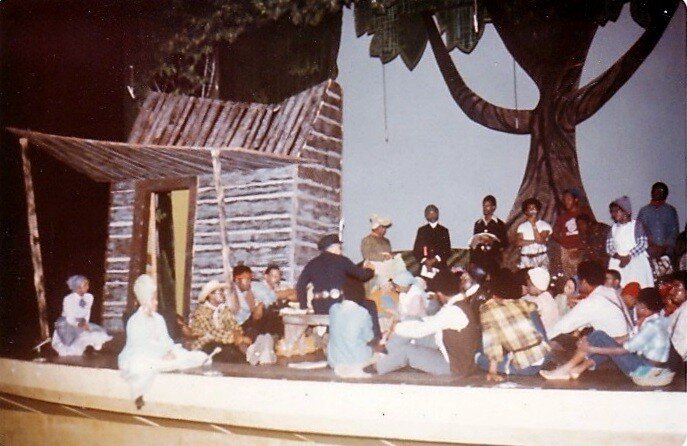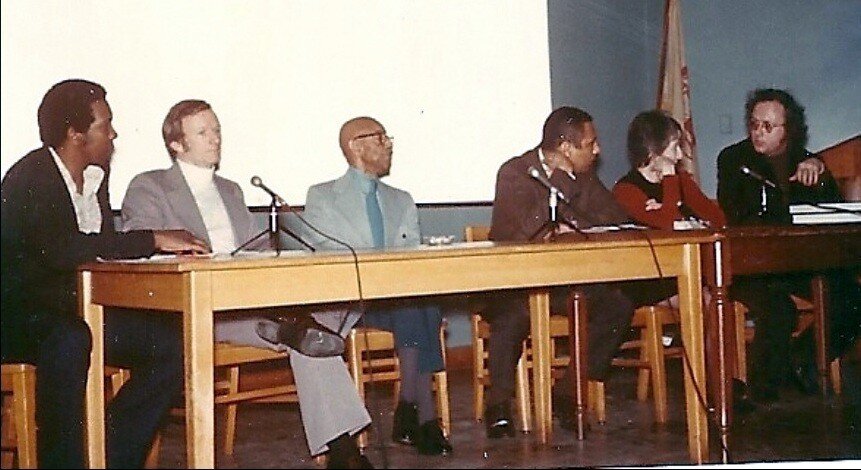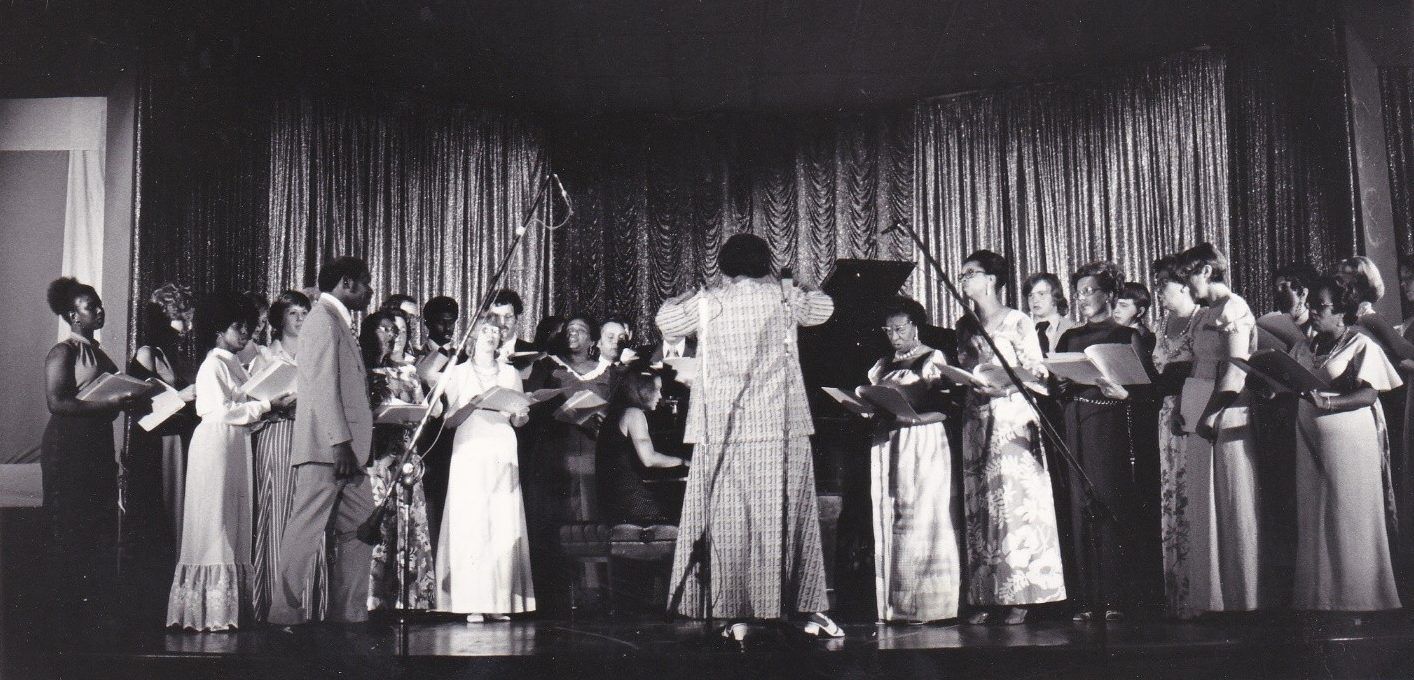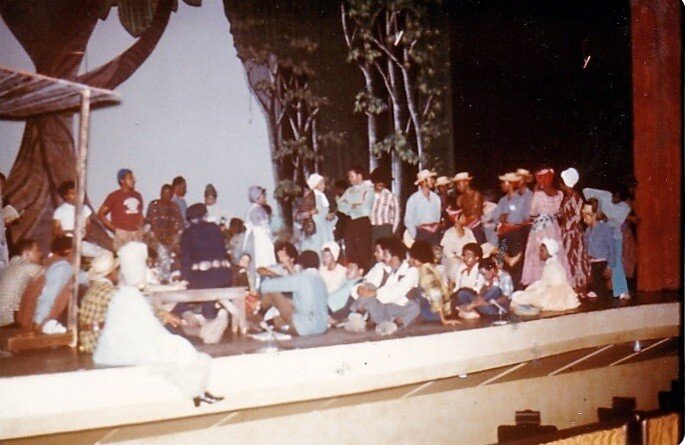Imagine the privilege of sitting a few rows behind Eubie Blake on the night of January 28, 1972, and watching his whole body move to the music of Scott Joplin at the Atlanta premiere of Treemonisha, orchestrated by T.J. Anderson. Eubie was kind enough to autograph my program that night and again at a reprised performance with William Bolcom’s orchestration on August 15, 1972, at the first Wolf Trap Farm’s Filene Center. (Yes, the Center that burned in 1982.)
The story of Treemonisha encapsulates Joplin’s own story in a way and is the great drama of ragtime lore. Readers of TST undoubtedly know the story well or at the very least a Wikipedia version. Therefore, I won’t detail too much about the opera itself but rather, I’ll blow off the dust and share some of my experiences with Joplin’s opera and how my wife and I with 5-year-old son John happened to be in those seats for the Atlanta premiere.
Karen and I moved to Sedalia in 1965 right after we were married. She was just finishing her nursing program and was ready to begin her career. With her diploma securely in hand, I was about to return to college to complete my teaching degree having dropped out when my mother died and to get married. As I wrapped up my bachelor’s degree, I simultaneously began work on a master’s in history and fate decreed that I would be Dr. Alfred E. Twomey’s graduate assistant. An avocational interest of Dr. Twomey was grand opera. When it came time to select a thesis topic, he suggested that since I was from Sedalia, I should write about Joplin’s lost opera or his known opera, Treemonisha. I look back on that moment in 1968 and realize now how much that question attested to Dr. Twomey’s depth of knowledge about American opera and composers. And so, began my interest in Sedalia ragtime and Joplin’s operatic works.

By the time I finished my graduate work in 1971 I was so involved in the dream of a great ragtime event in Sedalia that the paper my adviser suggested had gone by the wayside and I wrote (rather poorly) on an easier topic, “The Impact of Darwin’s Theory of Biological Evolution on Nineteenth Century Anglican Theology.” (Stay with me, as I’m prone to this type of digression.)
With degree in hand I began teaching in the still segregated African-American Hubbard Elementary School in Sedalia. In the midst of my ragtime research I read of the upcoming New York Public Library publication of Joplin’s collected works and the January 1972 premiere of Treemonisha in Atlanta. My sainted principal, Mrs. Dorothy Kitchen, arranged for me to have two personal days and my family was blessed to be able to attend the premiere.
Morehouse College was one of the sponsors of the event and they held a workshop and lecture the afternoon before the concert. I arrived just in time to hear a most distinguished panel discuss the opera and then to hear Rudi Blesh describe the life of Scott Joplin.

The panel was a gathering of ragtime authorities. Carman Moore lead the discussion and was just beginning his distinguished career there at Morehouse. Max Morath, Eubie Blake, T.J. Anderson, Vera Lawrence, and William Bolcom set forth on a lively discussion about Joplin’s opera and the significance of the premiere. Anderson and Bolcom, I have always felt, were to become victims in what I fear was another unfortunate tale of the opera. But that’s story for another time.
I want to share some thoughts about attending the premiere Joplin had dreamed would occur in his lifetime. I was so excited to be at the hall that night and when I discovered a door to the house untended an hour before the doors were to be opened, I took the liberty of going in. I found the cast on stage for final notes and recognized Katherine Dunham from seeing her at East Saint Louis appearances. She was giving last minute suggestions in her role as Stage Director and Choreographer. Dr. Wendell Whalum was addressing the chorus as the opera’s Music Director. I tried to act like I was supposed to be there as a photographer. However, my little Instamatic camera gave me away and I was gently asked to leave by a remarkably kind usher who seemed to sense my near manic excitement and awe at simply being there.
Someday I would like to get the question of the three dueling orchestrations straightened out in my head. But that aside (along with the awful copyright issues that intruded on the opera’s triumphant appearance) my total lack of musical acumen, allowed me to find all three of the instrumental versions delightful. The three “premieres” were most memorable. Watching Eubie and buoyed by the additional enthusiasm of the audience at the first Atlanta production, made the experience unforgettable. I nearly lost the story as I was caught up humming the previous musical pieces in my head as it went along. I wasn’t disappointed that there were no discernable ragtime pieces. It was all just so filled with joy. When the mood was dark there was always the reemergence of that joy and I’ll always hear Aunt Dinah’s horn and feel the dancing that ended Act Two.
I had met Eubie Blake after the Morehouse panel the day before and had asked him and others about coming to Sedalia if we were to have a Joplin ragtime festival. Amazingly, when I went to him at intermission, he recalled our conversation the day before and repeated that he had performed all over the world, but he had never played Sedalia.
By the last number, the audience, after thunderous applause, joined Robert Shaw’s orchestra humming “A Real Slow Drag” as we left the Great Hall. We drove through the night to get back home but all I remember about that drive was replaying the music in my head and lamenting that Joplin hadn’t known the feeling I had experienced that evening.
I discovered that another version of the opera was to be presented at Wolf Trap Farm in Washington, D.C. in August 1972, so the first thing I did when we returned to Sedalia was order tickets. I had used all of our disposable income on the Atlanta trip, so I also had to begin figuring out how to fund a pilgrimage to D.C. at the height of tourist season. We paid for that one for several years.
The rest of the 1971-1972 year at Hubbard Elementary School went quickly for me. When I shared my dream of a Sedalia ragtime festival with my 8th grade students, I spotted Melinda Poole sketching my picture with a light bulb over my head.
I had purchased inexpensive tickets for seating on the grass at Wolf Trap. We were fortunate to have nice weather since we weren’t to be under the Filene Center canape. There was something different and exhilarating about listening to the opera outside under the stars. The music was more familiar the second time and I picked up a lot more of the story.
(And speaking of Joplin’s story, Susan Atilla is writing a thoroughly researched blog on the influence of Booker T. Washington’s Tuskegee Philosophy on Joplin and his opera. I should think from what I have read, it should easily qualify for a Ph.D. should she be in a University program. The well documented and researched paper is at www.sueattalla.com/blog/category/treemonisha)
After a great confusion over hotel reservations we did the usual tours tourists endure in the nation’s capital. (The next time I was in D.C. in 2015, I was astonished to recall how much freedom we had had on our first visit compared to the constant queues, checkpoints and searches in the post 9/11 era.)
But then we delighted in seeing Treemonisha again and appreciated being more familiar with the story. There was such a party-like atmosphere about the pre-concert picnics on the lawn and everyone near us seemed quite well informed about Joplin’s music. I wish I had taken names that evening but I never imagined I’d be writing an article about the experience, nearly fifty years later.
At an intermission I found Eubie Blake again seated among some very distinguished friends. Mrs. Jouette Filene Shouse, the benefactor of Wolf Trap’s Filene enter, was hosting Eubie in the Presidential Box. A number of Nixon cabinet members were also there with him.
Eubie didn’t recognize me this time but his wife did, and I introduced Marion to my wife Karen. They had a nice visit before the lights flashed and the music began. It was nice to have seen the opera back in January, but this time it seemed to go much faster. The ending was as exuberant as ever and before the “finale,” Eubie was ushered onto the stage. The audience was euphoric, and the cast, chorus, and dancers crowded around the “guest of honor” and of course Eubie was in his element. When the orchestra began to play again, Eubie broke into a strutting cake-walk that outdid the dance company’s exit, and the audience joined in the festivities. I would like to have seen the opera one more time, but we had to get back to Sedalia.
You will have to permit me another diversion here that relates to meeting Marion Blake. Eubie was contracted to be a headliner at the first Joplin festival in Sedalia but Marion called me a week before it was to begin to tell me Eubie couldn’t come. It seems, Eubie was recovering from pneumonia and had to have a nurse give him a shot every day and administer his other meds. I was relieved to know the problem and reminded Marion that she had met my wife at Wolf Trap, and they had visited. I told her that Karen was a Registered Nurse and could not only give the shots, but she would be Eubie’s nurse 24/7 while he was in Sedalia. She realized that would relieve her for a few days and that Eubie would be better off at the Festival.
However, Eubie took an instant dislike to Karen, the minute she gave him the first shot in the hip. The doctor had sent a hypodermic needle a vet would have used, and it really hurt him no matter how careful Karen tried to be. Eubie couldn’t have weighed 80 pounds dripping wet and she couldn’t find much “hip” in which to stick a needle. Karen who was the most considerate person I know was devastated that the star of the show fussed about her the whole time he was there. Every time Eubie’s name came up over the years, Karen cringed. Later Marion told Karen the New York’s nurses also had trouble with the inoculations and Eubie didn’t care much for them either.
In November 1972, the first of the local productions of Treemonisha of which I’m aware was staged by the Southern Illinois University at Carbondale. In fact, they nearly upstaged the Atlanta premiere. It seems a student and ragtime enthusiast knew of Trebor Tichenor’s piano score of the opera and young student suggested that the University produce the work. By the time the University was ready to begin they had heard of the Atlanta premiere, and then the Wolf Trap production, and so they began negotiating with Very Brodsky Lawrence to present Treemonisha at Illinois University. They used William Bolcom’s orchestration and Katherine Dunham, who was from across the bridge in East St. Louis, reprised her role as stage director and dance coordinator. They even negotiated the use of the original Atlanta sets and costumes. It was a very credible production.
The next Treemonisha episodes in my life came at the 1974 Scott Joplin Ragtime Festival. I had arranged with Vera Lawrence to perform several selections from the opera. My amazing colleague who taught music at Hubbard School, Katheryne Rayford, was to gather, rehearse, and direct a bi-racial Sedalia Chorus for one of the concerts. This was remarkable when I consider that the Sedalia public schools had only been integrated for a year and many of the African-American members of the chorus had never been inside the Liberty hall auditorium.
The night of the performance I was informed that there was a lawyer from New York in the foyer who wanted to speak with me. I was told that if we performed any part of the opera, we would owe royalties to the owner of the copyright. Apparently there had been a mix-up as I had previously received permission from Ms. Lawrence for an unpaid amateur chorus to perform up to ten pieces. Some urgent calls from a pay phone (what I wouldn’t have given for a cell phone back then) and we were allowed to go ahead with the details to be worked out after the festival. Later it was all ended quite simply without compensation. The only cost was to my frazzled nerves.

Before I leave this unfortunate incident. I will point out that when the festival was resurrected in 1983 the coordinator had the same difficulty while trying to stage some chorus numbers from the opera. This time it was a Florida attorney exacting a royalty payment for the still mysterious “Trust,” but after coming to Sedalia, he relented, and the chorus performed.
The second 1974 episode related to Treemonisha, was a much more pleasant one. Rudy Blesh, one of the authors of They All Played Ragtime, was a festival symposia headliner and he found me backstage in the middle of the last concert. He had a large package in his hands and asked if he could present something to us on stage as a token of his delight and admiration for Sedalia hosting the event. I asked Jake Siragusa, the Chamber of Commerce president to accept the gift and the Artistic Director Dick Zimmerman made a spot for Rudy on the program. To our great surprise, Rudy gave us one of the piano/vocal/scores of Treemonisha Joplin’s wife Lottie had given him. It had belonged to Joplin of course and was a rather tattered copy presumably a chorus member, Kurt Stern, had used during the famous read-through in New York sometime between 1911 and 1915. Stern’s name was handwritten eight times throughout the score.
We stayed up most of that night setting up for Sunday’s concert in the park but when I got back home around five o’clock the next morning, I was far too tired to rest, so I put on archival gloves and carefully turned each page of that old score, in a kind of trance. I imagined I was somewhere in New York listening to Joplin giving instructions to his chorus. I later conserved the old folio as if it was the Declaration of Independence in the National Archive dutifully rising out of the floor each morning and descending back into the vault at night. I’m prone to exaggeration, but holding that document was one of the great highlights I had that so rewarded the work on the festival.
In the midst of planning for a 1975 event, my family had one more opportunity to experience a live “premiere” performance of Treemonisha. This time it came as a personal invitation to attend the Houston Grand Opera performance with a score orchestrated by Gunther Schuller. It is still hard for me to get over being treated like a celebrity when at a ragtime event just because I was from Sedalia. There was an aura about the place to many in the ragtime community that rubbed off on me and that was certainly true in Houston.
This performance in May 1975 was quite theatrically presented with a grand set and costumes designed by the Metropolitan Opera designer Franco Colavecchia. His designs were often controversial (his costumes were occasionally nothing at all) but I found his work on Treemonisha quite innovative and apropos. When I learned that this production was intended for Broadway, I better understood the concepts Colavecchia was employing (though I did have to wonder if the creatures slithering around the floor in loin clothes in Houston would be wearing them on Broadway…)

This production was as exciting for me as the others and the overall staging had been ramped up several notches. I sought out Franco to see if his original sketches would be available to display in Sedalia, but he was going to need them for the New York staging. He later wrote me about doing something but by then I was about to leave Sedalia. I did contact him again a few years ago about coming to Sedalia, but it didn’t work out for me to promote his appearance then when my wife passed away. He is retired now in Rhode Island but seems to still be interested in doing something at a Sedalia festival.
I found Gunther Schuller in the admiring throng after the Houston performance. He had been kind enough to arrange to have his New England Conservatory Ragtime Ensemble come to the first festival and he had already agreed to send them to the 1975 event. His autograph on my opera program gave me another wonderful souvenir rounding out a complete set of the first three “premiere” orchestrations.
In 2000, the St. Louis Opera Theater produced Treemonisha with Schuller’s score and it was grand opera on as grand a scale as St. Louis could produce. The more intimate venue at the St. Louis Repertory Theater changed the mood of the classic for me and I found the music, well performed as it was, a bit much for the space. I have assisted docents at the Rep and am always so impressed by the sets and costuming for all the productions. However, the obligatory tree didn’t work for me. The three-sided seating at the Rep necessitates that modest stage designs be adapted for the two hundred-seventy degree viewing angle and that created very different blocking situations. I really have nothing major to criticize having nothing specific to criticize. Opera Theater St. Louis rarely disappoints.
Though my last episode with Treemonisha has not been an in-person experience like the others, it is nevertheless significant. Having now had the joy of listening to Rick Benjamin’s Paragon Ragtime Orchestra’s recent recording and of reading Benjamin’s extensive liner notes I have a whole new appreciation for Joplin’s opera. I first learned of the Benjamin orchestration from Max Morath. He was so impressed, and he sent me the CD set. On several occasions now I have listened to both the Benjamin orchestrated recording and the Schuller orchestration. While I find the most recent effort lighter and probably more authentic, I also still thoroughly enjoy the earlier Grand Opera orchestrations…probably because I was at the performances.
I’ve been wanting to chronicle my rich experience with Treemonisha for a long time. And, if I ever get back to Sedalia with some extra time, more than anything I would like to listen to a recording and follow along with Rudi Blesh’s old score again. Holding something Blesh and Joplin held is about as close to knowing “The King of Ragtime” as I can imagine.
Also see: Treemonisha’s Premiere, 50 Years On
Larry Melton was a founder of the Scott Joplin Ragtime Festival in 1974 and the Sedalia Ragtime Archive in 1976. He was a Sedalia Chamber of Commerce manager before moving on to Union, Missouri where he is currently helping to conserve the Ragtime collection of the Sedalia Heritage Foundation. Write him at lcmelton67@gmail.com.






















